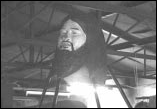|
|
 |
監督:森達也 Director : Mori Tatsuya |
|
ドキュメンタリーはふつう、正義のマイノリティーの立場、政治腐敗と手を組む政治権力に対して社会正義を追求する被抑圧者の立場に立つことで、社会悪を露呈していく。だが、ここでいう主体“A”、すなわちオウム真理教は、けして高潔な負け犬などと呼べたものではない。狂気のグル、麻原彰晃に率いられたカルト信者がサリン攻撃、暗殺、仲間のリンチで数十人の人命を奪った。それに対して、警察は最大規模の捜索で対応し、数百人の信者が劇的な状況下で逮捕された。そして、多くの日本人が一年以上もテレビに釘付けになった。 森達也は未逮捕の信者に密着取材し、彼自身も殺人集団のシンパとして非難を受けながらも、信者の視点から一連の事件を記録しつづけた。この彼の大胆不敵な選択が主流のメディアが認めえないような批判的なスタンスによるドキュメンタリー製作を可能にした。彼のキャメラが無実の信者を追及する横暴な刑事を捉えた場面では、社会一般の腐敗が、オウムのような悪の“他者”の目を通してより鮮明に映し出されてくる。 森はそのビデオ録画を信者を釈放するために使おうと決断するが、その決断はまた、彼の考えるところのドキュメンタリー映画の本質と重なってくる。つまり、ドキュメンタリー映画は、善対悪という叙述的な単純さを複雑化する必要性、そして人間の徳を追求しつづける重要性を告発するメディア媒体であるというのだ。マスメディアは、カルト信者らを悪魔に仕立て上げ、人権保護の必要のない非人間的な集団と決め付けるような国民的なヒステリーを助長してきたが、森のスタンスはそのようなマスメディアに対抗して、信者らの人間的な側面を強調することに集中している。一人の信者がオウムの戒律を破って彼の祖母の家を訪ねる場面では、警察・メディアの非道行為や社会からの排斥ではなくて、人間的な交流こそが、オウムとそして社会一般の悪を解決する手段なのだと訴えているのだ。 |
Documentary usually exposes social evils by championing the side of the just minority, the oppressed few who struggle for what is right in the face of the machinations of the corrupt and powerful. Aum Supreme Truth, the subject of A, is by no means a righteous underdog, however. Led by their mad guru, Asahara Shoko, many of the cult's believers killed dozens in chemical attacks, assassinations, and even lynchings of their own members. The police responded with a full-scale assault, arresting hundreds in a shocking drama that kept most Japanese glued to their televisions for over a year. By following the remaining cult members with his camera and taking their side spatially, Mori Tatsuya exposes himself to charges of sympathizing with a murderous cabal. But it is his daring choice of perspective that provides him with a critical stance none of the major media were able to assume. When his camera captures a police detective in the act of shamelessly framing an innocent believer, it becomes clear that the corruption of normal society is sometimes more manifestly exposed through an evil Other like Aum. His decision to use that video to free the believer is also Mori's
statement on documentary, on the necessity to complicate the narrative
simplicities of good versus evil, as well as on the importance
of a commitment to human values. Against a mass media that demonized
the cult members, fomenting a hysteria which rendered them inhuman
and thus without rights, Mori emphasizes their all-too human side.
And when he shows one's visit to his grandmother --a taboo in
Aum society--he underlines that it is human contact, not ostracism
nor police and media brutality, that will solve the evils of both
Aum and normal society. |